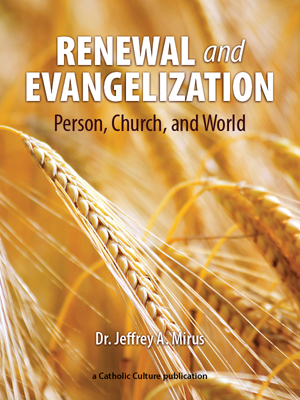Church Fathers: St. Irenaeus of Lyons, Part I
By Thomas V. Mirus ( bio - articles - email ) | Jul 23, 2015 | In Fathers of the Church
As we have seen, the problem of heresy became an increasingly pressing issue for Christians towards the end of the second century. Popes and bishops excommunicated the inventors and adherents of heresies and wrote pastoral letters warning the faithful. Among these protectors of the flock were the last four popes of the century—Soter (166-174), Eleutherius (174-189), Victor I (189-198), and Zephyrinus (198-217)—as well as bishops like Dionysius of Corinth, Pinytus of Gnossus, and Serapion of Antioch.
Free eBook:

|
| Free eBook: Renewal and Evangelization |
Meanwhile, theologians wrote works refuting the heresies while proving and expounding the true apostolic teaching. Most of these works are lost, with only small fragments or descriptions surviving in Eusebius. Among these writers were Apollonius, bishop of Ephesus; Caius, a Roman priest under Pope Zephyrinus; and Rhodon, the disciple of Tatian mentioned in the installment on early heresies.
We have a few more substantial fragments by Hegesippus, a convert from Judaism born in Syria or Palestine. Because of the spread of Gnosticism, he made a journey to gather information about the true doctrine from the most important (apostolic) Churches, particularly the Church of Rome, where he came during the reign of Pope Anicetus (155-166). Somewhere during or just after the reign of Pope Eleutherius, he returned home and compiled his memoirs in five books, known as his Commentaries on the Acts of the Church. In the surviving fragments, he focuses on the early history of the Church of Jerusalem, comments on the uninterrupted succession of popes which guarantees authentic apostolic doctrine, and lists the Jewish and early Gnostic sects.
St. Irenaeus of Lyons
By far the greatest anti-heretical writer—indeed, the greatest second-century theologian—was St. Irenaeus of Lyons. Irenaeus is sometimes called the father of Catholic theology because of the comprehensive detail in which he explained and defended the articles of the true faith. He did this in the course of his other main achievement: dealing a mortal blow to Gnosticism.
Irenaeus was born in Asia Minor, probably in Smyrna, where as a lad he heard St. Polycarp preach. At some point he made his way to Lyons in Gaul. He is first mentioned in 177 as a priest in Lyons, at which time he was probably about 37 years old. That same year, he was sent to Rome with a letter from the Christians of Lyons to Pope Eleutherius concerning the Montanists in Lyons. Away on this mission, Irenaeus escaped Marcus Aurelius’s persecution, one casualty of which was the 90-year-old bishop of Lyons, St. Pothinus, who died of mistreatment in prison. Upon his return, Irenaeus was appointed as Pothinus’s replacement.
The name Irenaeus means “peacemaker”; Eusebius remarks that this is appropriate, since around 190 Irenaeus tried to make peace between Pope Victor I and Polycrates of Ephesus during the Quartodeciman controversy over the date of Easter. After that event the record is silent about Irenaeus. He may have died around 202. There is a tradition of his martyrdom which is generally considered unreliable, as it is not mentioned until St. Gregory of Tours’s sixth-century History of the Franks.
Surviving Texts
Only two works by Irenaeus have survived fully. The more important, on which his reputation rests, is the five-volume Detection and Overthrow of the Gnosis Falsely So-Called, more commonly referred to as Adversus haereses (Against Heresies). It is the earliest work that can be called a catechism of Christian doctrine, and as the title indicates, it was composed to refute current heresies falling under the umbrella of Gnosticism.
The five books were written in Greek between 180 and 199. While most of the original Greek text can be pieced together from various fragments, the complete work is only extant in a highly literal Latin translation, likely made as early as 200. An Armenian translation of books IV and V is also extant, as well as fragments of Syriac translations.
Pope St. John Paul II remarked that Irenaeus understood "that one cannot respond to a religious ideology without knowing it well. That is why, before refuting such an ideology, he must gather information and understand it." Thus, in Book I, Irenaeus gives an extremely detailed description of the teachings of the various Gnostic sects, which he learned from their treatises and from personal conversations with them, as well as the works of earlier anti-heretical writers. Since most of the Gnostic writings are lost, even after the Nag Hammadi discovery in 1946, this work is still one of our primary sources on the various Gnostic sects.
Irenaeus rightly comments that simply to state the Gnostic doctrines is to show their absurdity, but proceeds in Book II to refute Gnosticism using reason. In books III, IV and V, he continues to refute the Gnostics on various points, particularly their misuse of Scripture, while setting out positively the true apostolic doctrine.
By his own admission, Irenaeus possessed little rhetorical or literary skill, and the work as a whole is somewhat disorganized and repetitive. But he sets out the teachings of the Church simply, clearly and in the spirit of truth, and more than adequately exposes the fraudulence of Gnosticism.
In 1904, a full Armenian translation of Irenaeus’s Demonstration of the Apostolic Preaching was discovered. This work, only the name of which had been known up to that point, is an apologetic treatise which establishes the fundamental tenets of Christianity. The author limits himself here to a positive exposition, referring the reader to Against Heresies for his refutation of Gnosticism.
Some fragments of Irenaeus’s other writings—treatises, sermons, letters—are preserved in quotation by other authors. Among these are part of a letter to the Roman priest Florinus in which Irenaeus recounts how he heard St. Polycarp’s preaching as a boy, and a passage from his letter to Pope Victor I in which he pleads with him not to excommunicate Polycrates of Ephesus.
The Rule of Faith
The “gnosis falsely so-called” against which Irenaeus directed his main treatise was a product of intellectual speculation unbounded by humility. The heretics wanted to create a version of Christianity suitable to their own intellects; they pretended to have discovered a new and higher doctrine which superseded the revelation of the New Testament, which they considered full of “symbols for the symbol-minded” (to borrow a pun from the atheist comedian George Carlin). So they embellished doctrines to please their finite and puffed-up intellects, inventing convoluted systems of divine beings beyond the God of revelation.
For Irenaeus, though, everything comes down to the one rule of faith which all Christians hold in common. This is the universal teaching handed down unaltered from the Apostles, the canon of faith stated in the baptismal creed. While the Gnostics have no unity and each sect puts forward its own contradictory doctrines, the teaching of the Church is the same throughout the world:
For the same faith is held and handed down by the Churches established in the Germanies, the Spains, among the Celtic tribes, in the East, in Lybia, and in the central portions of the world. (Against Heresies 1, 10, 2)
The authenticity of this doctrine is guaranteed by the uninterrupted succession of bishops down from the Apostles. The heretics are not successors of the Apostles and so do not possess “the certain gift of truth” (4, 26, 2).
Irenaeus writes that he is able to list the complete apostolic succession down to his own time, but since to do this for all the churches would take up too much space, he limits himself to "pointing out the apostolic tradition and creed which has been brought down to us by a succession of bishops in the greatest, most ancient, and well known Church, founded by the two most glorious Apostles Peter and Paul at Rome" (3, 3, 2). Then he makes his clearest statement of the primacy of Rome:
For with this Church, because of its more efficient leadership [an alternate translation is "higher rank"], all Churches must agree, that is to say, the faithful of all places, because in it the apostolic tradition has been always preserved by the (faithful) of all places. (3, 3, 2)
Irenaeus follows up with a list of Roman bishops up to the present time (the reign of Eleutherius), saying that “this is most abundant proof that there is one and the same vivifying faith which the Church has received from the Apostles, preserved until now, and handed down in truth” (3, 3, 3).
If the apostolic tradition preserves the same faith for all, then intellectuals cannot improve upon it nor can the simple-minded take away from it. Pope Benedict XVI said in an address on St. Irenaeus:
The true teaching, therefore, is not that invented by intellectuals which goes beyond the Church's simple faith. The true Gospel is the one imparted by the Bishops who received it in an uninterrupted line from the Apostles. They taught nothing except this simple faith, which is also the true depth of God's revelation. Thus, Irenaeus tells us, there is no secret doctrine concealed in the Church's common Creed. There is no superior Christianity for intellectuals. The faith publicly confessed by the Church is the common faith of all.
While Irenaeus emphasized tradition and was not one for speculative theology, neither was his faith static and formalized. Benedict again illuminates his thought for us:
For Irenaeus, Church and Spirit were inseparable: "This faith", we read again in the third book of Adversus Haereses, "which, having been received from the Church, we do preserve, and which always, by the Spirit of God, renewing its youth as if it were some precious deposit in an excellent vessel, causes the vessel itself containing it to renew its youth also.... For where the Church is, there is the Spirit of God; and where the Spirit of God is, there is the Church and every kind of grace" (3, 24, 1). As can be seen, Irenaeus did not stop at defining the concept of Tradition. His tradition, uninterrupted Tradition, is not traditionalism, because this Tradition is always enlivened from within by the Holy Spirit, who makes it live anew, causes it to be interpreted and understood in the vitality of the Church.
Previous in series: Background on Heresies
Next in series: St. Irenaeus of Lyons, Part II
All comments are moderated. To lighten our editing burden, only current donors are allowed to Sound Off. If you are a current donor, log in to see the comment form; otherwise please support our work, and Sound Off!







